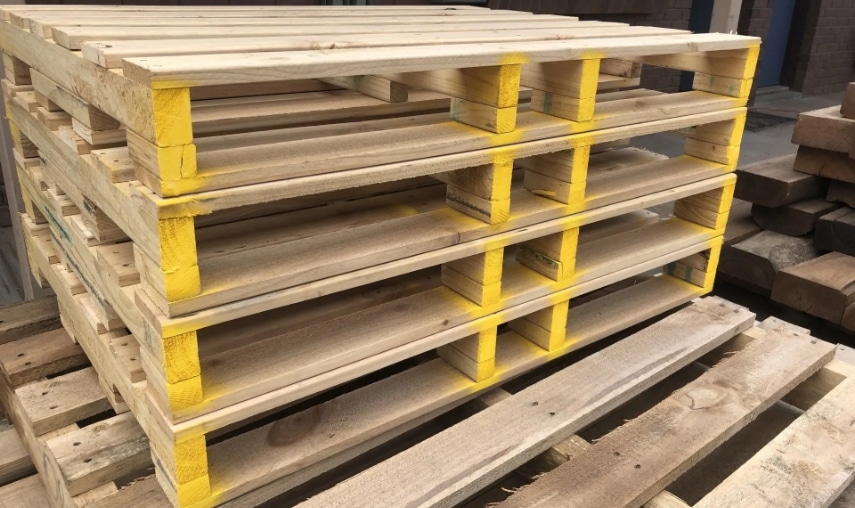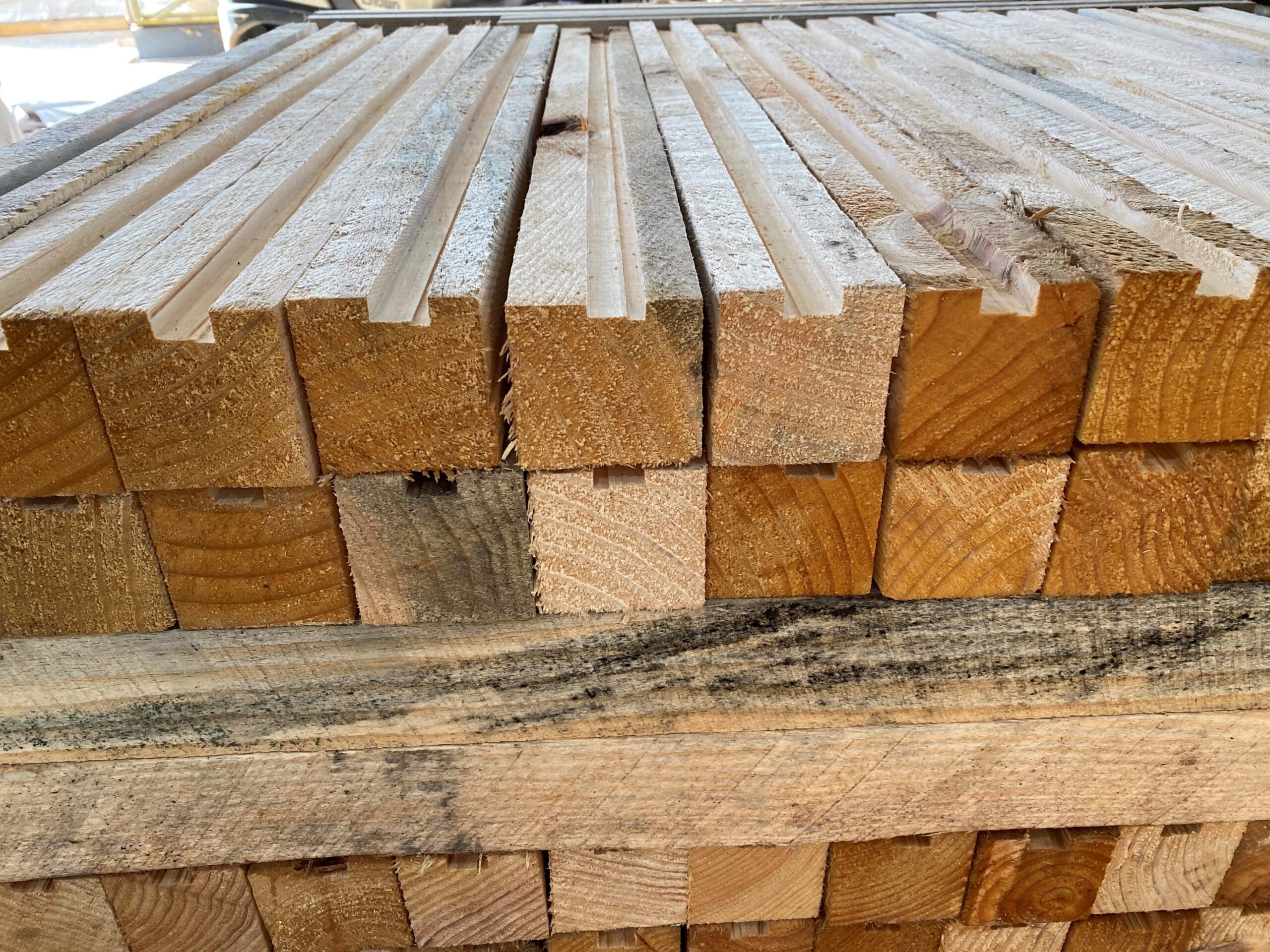Blogs
Choosing the Right Timber Pallets for Your Adelaide Business: A Comprehensive Guide
When it comes to the logistics and storage of goods in your Adelaide-based business, selecting the right timber pallets is a critical decision. Timber pallets are the unsung heroes of the shipping and warehousing world, silently supporting the flow of goods from one place to another. But with various options available, how do you choose the right ones for your specific needs? In this comprehensive guide, we'll walk you through the essential factors to consider when selecting timber pallets.
When it comes to selecting timber pallets for your business, the size of the pallet is the foundational factor to consider. Timber pallets are available in a range of dimensions, and making the right choice in this regard is important. The size of your pallets should harmonise with not only the size of your products but also the storage and transportation equipment you use. Let's delve into this critical aspect to understand its significance:
1 . Product Compatibility
The size of your timber pallets must align seamlessly with the dimensions of the products you intend to store or transport. Whether you deal with small components or bulky items, the pallets should provide a secure and stable foundation for your goods. Standard pallet sizes, such as 48x40 inches or 1200x1000 millimetres, are commonly used and widely recognised. However, the adaptability of timber allows for custom sizes to be crafted, ensuring a perfect fit for your specific products. This compatibility is essential to prevent any unnecessary movement or damage during storage or transit.
2. Maximising Storage Space
Efficient space utilisation is crucial, especially in warehousing and storage facilities. Timber pallets should fit comfortably within your available storage space, allowing for organised stacking without wasting valuable room. Oversized pallets can lead to inefficient space usage, while undersized ones might not make the most of your storage capacity. By selecting pallets that match the dimensions of your shelving units and storage racks, you can optimise your available space and store more products in the same area.
3. Loading and Transportation Efficiency
Timber pallets must also be designed with the loading and transportation process in mind. They should be compatible with the equipment used for handling, such as forklifts and pallet jacks. Pallets that are too large may pose challenges during loading and unloading, while those that are too small might not provide a stable platform for secure transport. Properly sized pallets ensure smooth and efficient operations in your logistics and distribution processes.
In summary, the size of timber pallets is a fundamental consideration in ensuring the efficiency and effectiveness of your logistics and storage operations. It directly impacts the compatibility with your products, maximises storage space, enhances loading and transportation efficiency, and allows for customisation to meet unique requirements. By carefully evaluating the dimensions of your pallets, you can streamline your processes, reduce the risk of damage to your goods, and ultimately optimise the logistics and storage functions of your Adelaide business.
In the process of choosing timber pallets for your business, a critical step that demands precision is assessing the weight of your products. This assessment is more than just a formality; it's an essential aspect of ensuring the safety, efficiency, and integrity of your logistics and storage operations. Let's delve deeper into why assessing your product weight is imperative:
1 . Understanding Individual and Variational Weight:
First and foremost, you must comprehensively understand the weight characteristics of your products. This involves more than just determining the average weight of individual items; it requires a nuanced assessment that accounts for variations. Here's why:
Individual Weight: Begin by determining the average weight of a single item or unit of your product. However, it's essential to recognise that not all items may weigh the same. Variations can occur due to manufacturing processes, material differences, or other factors. Therefore, it's prudent to consider the weight range of individual items to ensure that your chosen pallets can accommodate the heaviest units.
Cumulative Weight: If you plan to stack multiple units of your product on a single pallet, you must account for the cumulative weight. This is crucial as stacking multiple items can significantly increase the total weight load on the pallet. Failing to consider this can lead to overloading, structural stress on the pallet, and potential damage to your products during storage or transportation.
2. Ensuring Pallet Suitability:
The weight of your products directly influences the choice of timber pallets. Selecting pallets with inadequate weight capacity can result in pallet failure, causing significant disruptions, damages, and even safety hazards. Here's how assessing product weight ensures pallet suitability:
Optimal Weight Capacity: By knowing the weight characteristics of your products, you can select timber pallets with an appropriate weight capacity. This means choosing pallets that comfortably support the total weight of your products, both individually and cumulatively when stacked.
Safety and Integrity: Pallets that align with your product weight provide a safety net for your logistics and storage operations. Overloading pallets can lead to structural damage, posing risks to your products and personnel. By opting for pallets with the right weight capacity, you minimise these risks, ensuring the integrity of your goods.
3. Preventing Overloading and Damage:
Perhaps the most compelling reason to assess product weight is to prevent overloading and associated damages. Overloaded pallets can lead to various issues, including:
Pallet Breakage: Excessive weight can cause pallets to break or sag, rendering them unusable and potentially damaging your products.
Goods Falling: Overloaded pallets are more likely to experience goods falling off during transportation, leading to product damage and potential accidents.
Safety Hazards: Overloaded pallets pose safety hazards to personnel involved in handling and transporting goods, increasing the risk of injuries.
In conclusion, assessing your product weight is a basic step in selecting the right timber pallets for your Adelaide business. It entails understanding both individual and variational weights, accounting for cumulative weight, and prioritising safety and integrity. By meticulously assessing your product weight, you can make informed decisions when choosing pallets, ensuring the efficient and secure handling of your goods while minimising risks and disruptions in your supply chain.
Selecting the right timber pallets for your business goes beyond logistics and storage efficiency; it's a fundamental aspect of ensuring the safety and integrity of your operations. Central to this consideration is the weight capacity of your chosen pallets. Let's explore why ensuring safety and integrity through appropriate weight capacity is paramount:
1 . Structural Integrity:
When it comes to the supply chain, pallets deserve more credit than they are given. They bear the weight of goods as they travel from one point to another. However, like any structural element, pallets have their limits. Choosing pallets with the appropriate weight capacity is the first line of defence against structural failure. Overloading pallets beyond their capacity can lead to several critical issues:
Pallet Breakage: The structural components of pallets, such as beams and boards, are designed to withstand specific weight thresholds. Exceeding these limits can cause pallets to break or sag, rendering them structurally compromised and unsuitable for use.
Goods Falling: Overloaded pallets are more likely to experience goods falling off during transportation or handling. This can result in product damage, supply chain disruptions, and even safety hazards if items fall onto personnel or equipment.
2. Product Protection:
Your products are the lifeblood of your business, and safeguarding their integrity is paramount. Appropriate weight capacity in pallets plays a pivotal role in ensuring your products remain in optimal condition throughout the logistics process:
Minimised Damage: Pallets that align with the weight of your products reduce the risk of damage during transportation and storage. When pallets are overloaded, the additional stress can lead to product breakage, deformation, or spoilage.
Stability During Transit: Pallets with the right weight capacity provide stability during transit. This stability prevents products from shifting, colliding, or experiencing excessive vibrations, all of which can contribute to damage.
3. Personnel Safety:
Your personnel are valuable assets, and their safety should never be compromised. Overloaded pallets can pose safety hazards to personnel involved in handling, transporting, and unloading goods:
Risk of Injuries: When pallets fail due to overloading, there is an increased risk of injuries to personnel. This can result from falling goods, collapsing pallets, or accidents during manual handling.
Workplace Efficiency: Safety concerns stemming from overloaded pallets can lead to reduced workplace efficiency. Personnel may need to spend more time ensuring safe practices, slowing down operations.
In conclusion, ensuring safety and integrity through the appropriate weight capacity of timber pallets is a non-negotiable aspect of your logistics and storage operations. It safeguards against structural failure, minimises product damage, and prioritises personnel safety. By selecting pallets that align with your product weight, you not only protect your goods but also create a safer and more efficient workplace for your team. It's a proactive step toward smooth supply chain operations and the preservation of your business's reputation for reliability and quality
When it comes to timber pallets, one size doesn't fit all. In many industries, products have unique weight characteristics, dimensions, and handling requirements. This is where custom timber pallets step in as the ultimate solution. Let's delve into the world of custom solutions and understand why they play a crucial role in optimising your logistics and storage operations:
1 . Precision for Unique Weight Characteristics:
Not all products conform to standard weight norms, and this is especially true for industries dealing with specialised items. Custom timber pallets allow for precise tailoring to accommodate the exact weight characteristics of your products. Whether you're dealing with exceptionally heavy machinery or fragile, lightweight components, custom pallets can be designed to provide optimal support and protection.
2. Handling and Transport Efficiency:
Efficient handling and transportation are critical in logistics. Custom pallets can be engineered to ensure that your products are not just supported but also handled with ease. They can feature ergonomic design elements such as strategically placed handholds or lifting points, making it simpler for personnel or machinery to manoeuvre them safely.
3. Security and Stability Measures:
Safety should never be compromised in logistics and storage. Custom timber pallets offer the advantage of incorporating specific stability and safety features tailored to your goods. This can include added bracing, anti-slip surfaces, or securing mechanisms to prevent shifting during transit. These measures enhance the safety of both your products and the personnel handling them.
4. Minimising Wastage:
Custom solutions are designed with your precise needs in mind, which means you're not paying for features or dimensions that you don't require. This cost-effective approach minimises waste and optimises your expenditure on packaging and logistics.
5. Adapting to Varied Product Dimensions:
In industries where product dimensions vary significantly, standard pallets may not suffice. Custom timber pallets can be designed to accommodate varying product sizes and shapes efficiently. This adaptability ensures that your products are secured in a manner that minimises movement and maximises space utilisation during transport and storage.
6. Future-Proofing:
Custom pallets are future-proof solutions. As your product line evolves or expands, your pallets can evolve with them. This adaptability allows your business to scale without the need to rework logistics processes or invest in entirely new packaging solutions.
Therefore, custom timber pallets are the epitome of adaptability and efficiency in logistics and storage. They are tailored to your specific requirements, ensuring that your products are supported, protected, and handled with precision. By opting for custom solutions, you enhance safety, minimise wastage, and future-proof your logistics operations. It's a strategic investment that aligns your packaging with the unique needs of your Adelaide business, optimising every step of the supply chain.
When choosing timber pallets for your business, durability is a paramount factor to consider, especially if you plan to reuse your pallets extensively. Timber pallets have earned a reputation for their resilience and long lifespan, but several factors influence just how enduring they can be.
1 . Timber Type
The type of timber used in pallet construction plays a pivotal role in determining durability. Hardwood pallets, derived from robust timber species like oak or maple, are known for their superior strength and longevity. They can withstand substantial wear and tear, making them ideal for heavy-duty applications. In contrast, softwood pallets, made from timber varieties like pine, are generally less durable and more suitable for lighter loads or short-term use.
2. Construction Techniques:
Apart from timber type, the construction methods employed during pallet assembly significantly impact their durability. Well-constructed pallets with secure fastenings and sturdy support structures are more likely to withstand the rigours of transportation and storage. Carefully crafted joints and reinforcements can contribute to a longer pallet lifespan.
3. Treating for Protection:
In some cases, your pallets may face threats such as pests or exposure to harsh weather conditions. To extend the life of your pallets in such scenarios, consider opting for treated pallets. Timber treatments can provide resistance against pests, rot, and decay, ensuring that your pallets remain structurally sound and durable even when subjected to challenging environments.
To summarise, durability is a critical aspect of selecting timber pallets for your business. Hardwood pallets, sturdy construction, and protective treatments are key considerations to ensure that your pallets can withstand repeated use and maintain their integrity over the long haul. By prioritising durability, you can optimise your logistics operations, reduce costs, and contribute to sustainable and efficient transportation and storage practices.
As environmental concerns continue to grow, businesses are placing greater emphasis on sustainability in their operations. When it comes to timber pallets, there's an opportunity to make eco-friendly choices that benefit both your business and the environment.
1 . Responsible Sourcing:
Selecting timber pallets made from sustainably harvested timber is a responsible choice. This means that the wood used in pallet production is sourced in a way that maintains the health and diversity of forests. Sustainable forestry practices ensure that for every tree harvested, another is planted, maintaining a balanced ecosystem.
2. Recyclability and Reusability:
Timber pallets offer recyclability and reusability advantages. Pallets can be repaired, refurbished, and reused multiple times, extending their lifecycle. When a pallet eventually reaches the end of its usable life, the timber can be recycled into new products or used as biomass energy, reducing waste and environmental impact.
3. Reduced Environmental Footprint:
Choosing pallets that are easy to repair and maintain contributes to a reduced environmental footprint. Pallets that last longer and require fewer replacements result in fewer resources being consumed and less waste generated over time. This aligns with sustainable practices and reduces the overall impact on the environment.
In summary, by considering sustainability and environmental impact when selecting timber pallets, businesses can make eco-friendly choices. Opting for sustainably sourced timber, prioritising recyclability and reusability, and extending the pallets' lifecycle through repair and maintenance all contribute to reducing the environmental footprint of your pallet usage. These choices not only benefit the planet but can also lead to cost savings and improved sustainability credentials for your business.
Various industries and regions may have specific regulations governing pallets, particularly in international shipments. One notable regulation is ISPM 15, which outlines the requirements for wooden packaging materials used in global trade. Complying with these regulations is crucial for maintaining smooth and trouble-free logistics operations.
1 . ISPM 15 Regulations:
The ISPM 15 (International Standards for Phytosanitary Measures) regulations are designed to prevent the spread of pests and diseases through wooden packaging materials. These regulations require that wooden pallets and crates be treated to kill any potential pests and stamped with an internationally recognised mark, certifying compliance.
2. Avoiding Delays and Compliance Issues:
Choosing timber pallets that comply with such regulations is essential to avoid delays and compliance issues during transportation, especially in international trade. Pallets that do not meet these standards may be rejected at customs, leading to costly delays, fines, and disruptions to your supply chain.
In conclusion, ensuring compliance with regulations, such as ISPM 15, is a vital aspect of selecting timber pallets for your business. By choosing pallets that adhere to these standards, you can prevent logistical complications, maintain efficient transportation processes, and minimise the risk of costly compliance issues, particularly in international trade scenarios.
Last but not least, budget considerations play a crucial role in selecting the right timber pallets for your business. While quality is undoubtedly essential, it's equally important to strike a balance between quality and cost-effectiveness. Timber pallets are available in various price ranges, and exploring your options helps you find pallets that offer the best value for your specific business needs.
Additionally, remember that the long-term benefits of investing in quality timber pallets, such as reduced maintenance and replacement costs, can often outweigh the initial expense. Ultimately, by carefully considering your budget alongside other critical factors, you can make a well-rounded decision that positively impacts your business's efficiency and sustainability.
In conclusion, choosing the right timber pallets for your business requires a thorough evaluation of several key factors. These include size, weight capacity, durability, sustainability, compliance with regulations, and budget considerations. Taking the time to make an informed choice not only ensures smoother logistics operations but also contributes to reduced costs and a more sustainable approach to your business's transportation and storage needs. By considering these factors in tandem, you can optimise your pallet selection process and make a decision that aligns with your Adelaide business goals and values.







